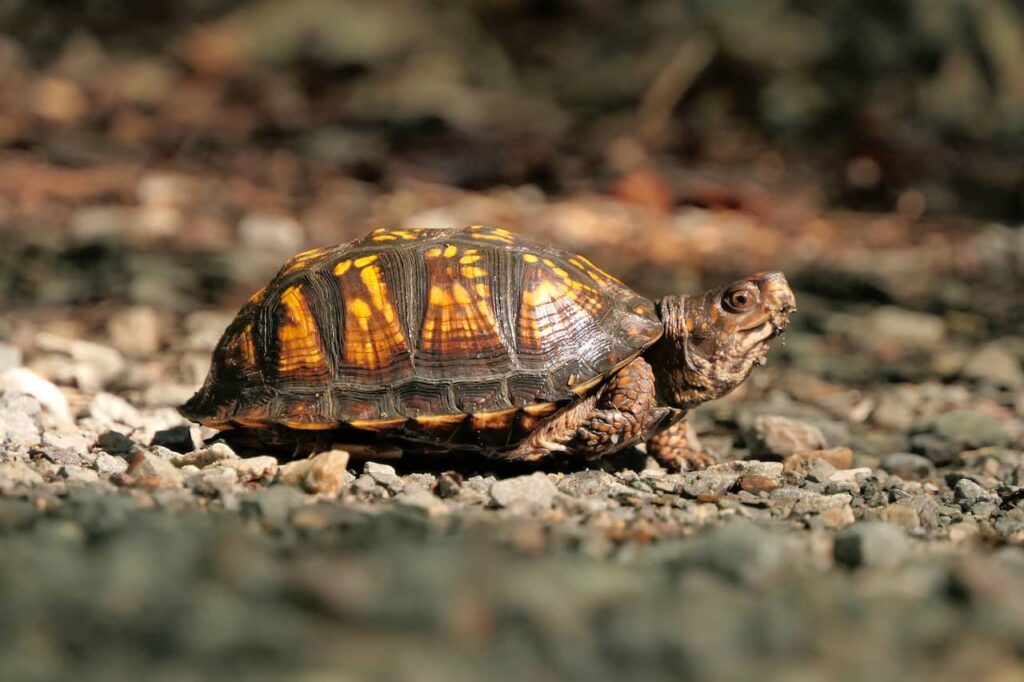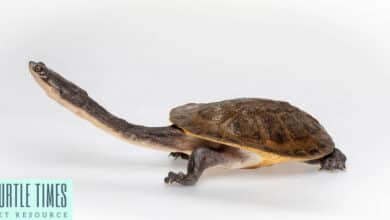Box Turtles
Box Turtles (Terrapene) are special turtles mainly found in the US, Asia and Mexico. They’re an important part of North America’s wildlife and have been known and loved for a long time.
There are currently four recognized species of box turtles: Common box turtle, Coahuilan box turtle, Spotted box turtle and Ornate box turtle.
The box turtle can be recognized by its domed shell, which is hinged at the bottom, making it possible for the turtle to close its shell tightly to keep predators out.
Primary Species
Going into the world of box turtles, we find that there are primarily four species that have been recognized in this genus. These are:
The Common box turtle: As the name suggests, this turtle is the most frequently encountered species among its peers.
Coahuilan box turtle: Native to the deserts, this species exhibits certain distinct features and behaviors that set it apart.
Spotted box turtle: Distinguished by its unique patterns, the spotted box turtle is an exquisite sight in the wild.
Ornate box turtle: Adorned with intricate patterns, the ornate box turtle is truly a testament to nature’s artistry.
A standout characteristic of the box turtle, which is often a source of fascination for observers, is its domed shell. But it’s not just the shape that captures attention; the lower section of its shell possesses a special hinge. This remarkable adaptation allows the turtle to pull its body in and shut its shell almost completely, much like closing a box. This tight closure serves as an effective defense mechanism, protecting the vulnerable turtle from would-be predators and environmental threats.

Where They Originate From
The roots of the box turtle are deeply entrenched in the landscapes of North America. Specifically, these turtles have evolved and thrived across various regions of the United States and Mexico. Their habitats vary widely, from lush forests to arid deserts, showcasing their adaptability and resilience. The rich history and distribution of box turtles in these regions suggest that they have been a longstanding part of North America’s ecological fabric. This origin story not only speaks to their survival prowess but also underlines the importance of preserving their habitats for future generations to appreciate and study.
Choosing and Buying
Box turtles, with their unique appearance and captivating behaviors, are frequently sought after as pets. However, their dwindling populations worldwide have raised significant concerns. With a considerable decline in their numbers, many states have taken the initiative to implement laws that restrict individuals from keeping wild box turtles in their homes. Opting for a captive-bred box turtle from a credible breeder or rescue organization should be a priority for several reasons:
Conservation: By choosing a captive-bred turtle, you contribute to the conservation efforts by not putting further strain on the wild populations.
Knowledge: Acquiring a turtle from a reputable source ensures that you have access to detailed information about its lineage, past care, and any pre-existing health conditions. This understanding can prove invaluable in offering your pet the best care possible.
Adaptability: Wild-caught turtles are often not adept at adjusting to a domesticated environment. The resultant stress can be fatal, leading to a shortened lifespan and multiple health complications.
Look out for any unusual bumps, redness on the shell, or nasal/mouth mucus. Cloudy eyes could be indicative of potential health problems. A sturdy shell without any swelling is a good sign. Additionally, it’s advisable to refrain from adopting a turtle during fall or winter. This is their hibernation period, and introducing them to a new environment during this phase could prove unduly stressful.

How To Care For Them
Handling
Having a box turtle as a pet is not just about its unique aesthetic appeal; it’s also a long-term commitment, requiring meticulous care and patience. These creatures have a lifespan that spans several decades. Their care demands thorough understanding and diligence.
Each species of box turtle comes with its distinct set of requirements. Some might prefer humidity, while others might need warm environments. Certain species have a penchant for basking, and there are even those that have a preference for brackish water over freshwater fresh water most commonly recognized member of this genus is the North American native, the common box turtle. With its high-domed shell painted in hues of brown, and patterned with either yellow or orange, it stands out distinctly. Its head is relatively petite, marked by a characteristic hooked upper jaw. Beyond its physical traits, the common box turtle is often celebrated for its vibrant personality, making it a fascinating companion. However, this also means potential turtle parents need to be well-prepared and informed to ensure these reptiles live a fulfilling and healthy life.
Common Health Issues
Box turtles, like all creatures, have their set of health issues to watch out for. A pressing health concern prevalent among turtles is metabolic bone disease, which is primarily attributed to inadequate UVB exposure. This debilitating condition not only inflicts pain on these gentle creatures but also weakens their bones, making them susceptible to fractures and ultimately leading to mortality.
Another frequent health challenge is respiratory infections. Usually arising from environmental inconsistencies, such as low humidity or suboptimal temperatures, these infections manifest symptoms like wheezing, nasal and oral mucus discharge, lethargy, and a diminished appetite. A recurring pattern of respiratory infections might indicate a potential deficiency in vitamin A. In such cases, feeding the turtle iceberg lettuce despite its popularity among these animals should be avoided, as it holds negligible nutritional value.
Moreover, box turtles can fall prey to parasitic infections. While captive-bred turtles demonstrate a reduced risk, it’s essential to remain vigilant. These infections might not always have visible symptoms, making routine checks by a specialized reptilian veterinarian imperative.
Yet another ailment to be wary of is shell rot. Stemming from bacterial or fungal infections, this painful condition is recognized by a dry or cracked appearance of the shell, often accompanied by an offensive smell. It is essential to consult a veterinarian immediately if any of these symptoms or conditions arise.

Appearance and Behavior
Box turtles exhibit an enchanting bond with their birthplace. These creatures, once born in a particular locale, tend to remain close throughout their lives. A pressing concern for their populations is human interference people often relocate them, causing these turtles to wander ceaselessly in search of their original homes, often to fatal consequences.
While they can defensively seal themselves entirely within their shells against predators like raccoons, their vulnerability is highest during the egg and hibernation stages. They possess a penchant for solitude, frequently seeking refuge under logs, brush, or even burrowing in sandy or muddy regions. As the cold months approach, most box turtle varieties enter hibernation due to limited food availability and reduced ambient warmth.
In captivity, box turtles generally exhibit docility towards humans and rarely display aggressive behavior, such as biting. However, caution is recommended, especially if one has been handling potential turtle foods; the scent can lead to inadvertent bites. A notable aspect of their behavior is the confusion induced by transparent barriers like glass, which they often tirelessly push against, resulting in stress.
Size and Lifespan
Box turtles are moderately sized terrestrial beings, measuring between 4.5-6 inches. They boast a high, dome-like shell adorned with a mosaic of yellow or orange patterns, which, interestingly, become less vivid as they age. Unique features to note include males having a concave underside (plastron) and often, red eyes. Furthermore, they possess the ability to entirely retract within their shells, courtesy of a hinged plastron. Their lifespan is admirable, often exceeding half a century. Intriguingly, females can store eggs post-mating and lay them years later.
Temperament
Box turtles aren’t universally ideal pets particularly for novices or young children owing to their intricate care needs and sensitivity to stress. They thrive in consistent environments and typically prefer minimal handling. While they are not naturally aggressive, stress-induced behavior might lead to occasional nips. Being potential carriers of salmonella, strict hygiene is crucial post-handling. Over time, they might develop a sense of familiarity, recognizing their caregivers and even exhibiting inquisitiveness from within their enclosures.
Housing Cooter Turtles
Enclosure Size
Providing ample space for box turtles is vital to ensure their well-being. For outside space, give the turtle a big area of at least 4 feet by 4 feet to move and enjoy. But if you’re keeping the turtle inside, make sure the space is at least 3 feet long and 1 foot wide. Larger is always better, allowing for natural behavior and exercise. Whichever environment you choose, the substrate, or base layer of the habitat, should be a generous 3 inches deep to cater to the turtle’s digging instincts.
Lighting
The importance of UVB lighting for box turtles can’t be overstated. UVB rays aid in the metabolization of calcium, crucial for maintaining healthy bones. The absence of sufficient UVB exposure can pave the way for metabolic bone disease, a debilitating condition that can prove fatal. Thus, whether you’re relying on the sun’s natural rays or using a UVB lamp, ensure your turtle receives around 12 hours of UVB light daily.
Temperature and Humidity
Box turtles flourish in environments that mirror their natural habitats. An outdoor pen, safe and customized for turtles, is an excellent choice, provided the temperatures remain above 50 degrees Fahrenheit. Features such as walls of a minimum height of 18 inches with overhangs, varied sunlit and shaded spaces, hiding spots, and a shallow water dish are essential. Moreover, safeguards against potential predators are crucial.
While an outdoor habitat is ideal, not all climates are conducive year-round. If housing your turtle indoors becomes a necessity, choose a spacious terrarium of at least 40 gallons. Repurposing items like children’s pools or large tubs can be a creative alternative. However, replicating the outdoor environment indoors demands meticulous planning and execution. This involves heat and UVB sources, hiding spots, and a water dish.
Considering hibernation, it’s a phenomenon box turtles might experience, especially if exposed to cooler temperatures or if they reside outdoors. Yet, allowing your turtle to hibernate requires vigilance; an unhealthy turtle may not recover from this prolonged rest. During hibernation, their metabolic rate significantly drops, potentially impairing their ability to combat illnesses.
For common box turtles, ideal daytime temperatures hover between 70 to 80 degrees Fahrenheit, with a basking area heated to about 85 to 90 degrees Fahrenheit. Night-time temperatures can safely range from 65 to 75 degrees Fahrenheit. Basking lamps, combined with ceramic heat emitters, are effective in temperature regulation. Furthermore, maintaining a relative humidity of around 60% is optimal. This can be achieved through regular misting and using a moisture-retaining substrate.
Substrate and Decoration
The choice of substrate impacts multiple aspects of a box turtle’s life in captivity: it regulates humidity, offers burrowing opportunities, and enriches the overall aesthetic of the enclosure. Choosing a substrate reminiscent of their natural habitat is essential. A mix of chemical-free topsoil combined with leaves and moss is a popular choice among turtle enthusiasts. Ensure a depth of at least 4 inches to facilitate your turtle’s innate burrowing behavior.
Food and Water
Box turtles are interesting animals that eat both bugs and plants. They eat different foods based on their age and what’s around them.
During their initial growth phases, young box turtles demonstrate a strong carnivorous inclination. As hatchlings, their diet leans heavily toward animal matter, which is pivotal in supplying the much-needed protein that fuels their rapid growth. This protein-rich diet primarily comprises insects, the easily available and abundant food source in their natural habitats.
Among the insect variety, slugs, cockroaches, crickets, worms, and grubs are particularly relished by these young reptiles. However, their opportunistic feeding behavior means they aren’t averse to feasting on larger prey. There have been instances where box turtles have been observed munching on small rodents or birds that are incapacitated or deceased.
As they grow older and transition into adulthood, the dietary balance shifts, incorporating more plant-based foods. Their vegetarian menu consists of leafy greens—like lettuce—moss, specific grass types, and even fungi like mushrooms. Intriguingly, some box turtle species consume poisonous mushrooms, an intriguing behavior that not only doesn’t harm them but makes the turtles toxic, providing a unique defense mechanism against potential predators.
Beyond the greens, these turtles have a penchant for fruits and berries, especially those that have fallen to the ground. Offering them a varied diet is crucial for their well-being. While a natural outdoor habitat provides them with a plethora of choices, in captivity, a mixture of fresh vegetables, fruits, insects, lean meats, and even young mice can be served. Commercially available box turtle food can be a convenient choice but should always be complemented with fresh produce to ensure a balanced diet. Always present their food on a flat surface like a plate or a paver to prevent accidental ingestion of substrate. Regular feeding schedules are essential, with younger turtles requiring daily meals, whereas some adults can be fed every alternate day. And, of course, a constant supply of clean water in a shallow dish is a must.
Breeding
In spring, box turtles become more active. After hibernation throughout winters, the next thing on their radar is to get food and breeding. The age to start mating in box turtles is 10 years. They don’t usually mate before that, and compared to other animals, it can be very late. After 10 years of life, box turtles are considered strong enough to do breeding and have turtle babies healthily. The mating can begin anywhere from April and go as long as Autumn.
Cleaning
Maintaining the hygiene of your box turtle is paramount for its overall health. Cleaning them is a relatively straightforward process but requires gentleness and attention to detail. Start by gently brushing the turtle’s shell using a soft brush. This action will help dislodge dirt, algae, or any other residue that might have accumulated. After brushing, use a cup or a scoop to pour clean water over the turtle, ensuring thorough rinsing. Continue the brushing process for the turtle’s legs, paying close attention to the crevices where the shell connects with the legs, tail, and head. These nooks can often harbor dirt, so they need meticulous cleaning. Conclude the process with another round of rinsing to ensure the turtle is spotlessly clean.
Conclusion
Box turtles, with their distinctive features and unique behaviors, offer a captivating insight into the intricate world of reptiles. Their diet, spanning both plant and animal matter, mirrors their adaptability to diverse environments. While young turtles showcase carnivorous preferences, adults balance their consumption between meats and greens. They’re creatures of habit and, as such, any decision to keep them in captivity should be accompanied by an effort to replicate their natural habitat, from the substrate used to the UVB lighting essential for their well-being. Breeding practices and their cleaning routines further demonstrate the intricacies of their lives.





